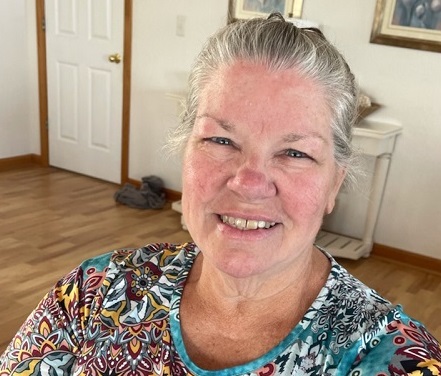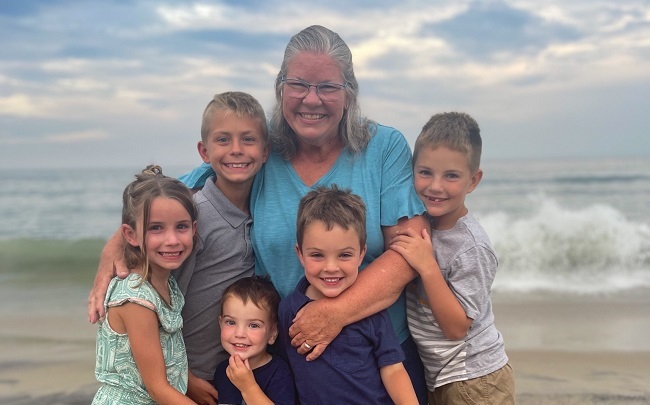Diagnosed a decade ago for lymphoma, Denise Schoolman was in remission, in the clear she thought.
That is, until a few weeks ago when her mammogram denoted something that required more testing and ultimately a diagnosis of invasive ductile carcinoma. It all started with the annual mammogram detecting a tumor less than an inch in diameter.
“Thank goodness I had that mammogram,” Schoolman said.
 The retired Heyworth woman met with a team that included an oncologist, a surgeon and a radiation oncologist in the breast cancer clinic at Carle Cancer Institute Normal to lay out her plan. She had surgery to remove the tumor and a plan for 21 radiation treatments. “I have a 90% chance it will not come back,” she said.
The retired Heyworth woman met with a team that included an oncologist, a surgeon and a radiation oncologist in the breast cancer clinic at Carle Cancer Institute Normal to lay out her plan. She had surgery to remove the tumor and a plan for 21 radiation treatments. “I have a 90% chance it will not come back,” she said.
Denise exemplifies the importance of having a mammogram, no matter what your family medical history. She learned through genetic testing that breast cancer is not hereditary in her family.
“The biggest myth to dispel is a woman cannot get breast cancer if none exists in her family history,” Matty Francois, MD, FACS, breast cancer surgeon at Carle Cancer Institute Normal, said. Francois started out as a general surgeon, but now she focuses on breast cancer care and treating benign cancer disease. She is the only surgeon dedicated to breast cancer at Carle Cancer Institute Normal.
Unless otherwise instructed by their provider, any woman over the age of 40 should start having annual mammograms and those at high risk may need it at an earlier age, Francois said. When are mammograms no longer needed? Francois said it depends on a person’s functionality.
“I tell patients if you are still active, dressing yourself, driving, you should have a mammogram,” she said. “It comes down to having a conversation with your primary care doctor.”
She recommends another conversation with the primary care provider about the need for a high risk stratification evaluation, which takes five minutes. Depending on the evaluation, a patient could need additional testing. Stratification results are reviewed in detail with the patient at the high risk breast clinic located at Carle Cancer Institute in Normal or Carle Cancer Institute in Urbana.
“We have learned so much about breast cancer and that information changes every two years,” Francois said. “I have seen mammograms detect a cancer one-fifth of an inch in size. When you find something that small, it is more treatable.”
Men as well as women can get breast cancer, she said. “Self-exams are an adjunct to a mammogram, but not a replacement,” she said. “As long as your provider recommends getting a mammogram, you should get a mammogram.”
If cancer is detected, the high risk breast clinics at both Normal and Urbana provide a nurse navigator and a team of a surgeon, oncologist and radiation oncologist to come up with a plan for the patient to move forward. The clinics also follow each patient for the rest of their lives to ensure they have the support they need.
Schoolman is one of those patients. She plans to complete 21 radiation treatments and she chose to have the tumor removed from her breast tested to see if it is likely to recur. She said the accuracy of the test is 97%, and if the test shows a likelihood cancer will return, she will proceed with chemotherapy treatments.
“I am still preaching to everyone I know, get your annual mammogram,” Schoolman said.
That is, until a few weeks ago when her mammogram denoted something that required more testing and ultimately a diagnosis of invasive ductile carcinoma. It all started with the annual mammogram detecting a tumor less than an inch in diameter.
“Thank goodness I had that mammogram,” Schoolman said.
 The retired Heyworth woman met with a team that included an oncologist, a surgeon and a radiation oncologist in the breast cancer clinic at Carle Cancer Institute Normal to lay out her plan. She had surgery to remove the tumor and a plan for 21 radiation treatments. “I have a 90% chance it will not come back,” she said.
The retired Heyworth woman met with a team that included an oncologist, a surgeon and a radiation oncologist in the breast cancer clinic at Carle Cancer Institute Normal to lay out her plan. She had surgery to remove the tumor and a plan for 21 radiation treatments. “I have a 90% chance it will not come back,” she said.Denise exemplifies the importance of having a mammogram, no matter what your family medical history. She learned through genetic testing that breast cancer is not hereditary in her family.
“The biggest myth to dispel is a woman cannot get breast cancer if none exists in her family history,” Matty Francois, MD, FACS, breast cancer surgeon at Carle Cancer Institute Normal, said. Francois started out as a general surgeon, but now she focuses on breast cancer care and treating benign cancer disease. She is the only surgeon dedicated to breast cancer at Carle Cancer Institute Normal.
Unless otherwise instructed by their provider, any woman over the age of 40 should start having annual mammograms and those at high risk may need it at an earlier age, Francois said. When are mammograms no longer needed? Francois said it depends on a person’s functionality.
“I tell patients if you are still active, dressing yourself, driving, you should have a mammogram,” she said. “It comes down to having a conversation with your primary care doctor.”
She recommends another conversation with the primary care provider about the need for a high risk stratification evaluation, which takes five minutes. Depending on the evaluation, a patient could need additional testing. Stratification results are reviewed in detail with the patient at the high risk breast clinic located at Carle Cancer Institute in Normal or Carle Cancer Institute in Urbana.
“We have learned so much about breast cancer and that information changes every two years,” Francois said. “I have seen mammograms detect a cancer one-fifth of an inch in size. When you find something that small, it is more treatable.”
Men as well as women can get breast cancer, she said. “Self-exams are an adjunct to a mammogram, but not a replacement,” she said. “As long as your provider recommends getting a mammogram, you should get a mammogram.”
If cancer is detected, the high risk breast clinics at both Normal and Urbana provide a nurse navigator and a team of a surgeon, oncologist and radiation oncologist to come up with a plan for the patient to move forward. The clinics also follow each patient for the rest of their lives to ensure they have the support they need.
Schoolman is one of those patients. She plans to complete 21 radiation treatments and she chose to have the tumor removed from her breast tested to see if it is likely to recur. She said the accuracy of the test is 97%, and if the test shows a likelihood cancer will return, she will proceed with chemotherapy treatments.
“I am still preaching to everyone I know, get your annual mammogram,” Schoolman said.
Categories: Community
Tags: Bloomington-Normal, Carle Cancer Institute, Champaign-Urbana, Eureka, Hoopeston
